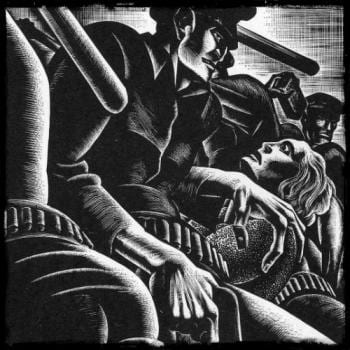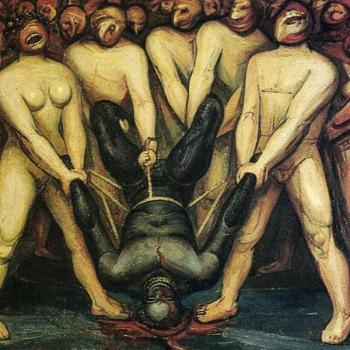
Long before Donald Trump seized his spurious, self-canceling political moment as the imagined defender and champion of the “hardworking Americans” maligned as “deplorables” and “garbage” by out-of-touch, elitist Democrats such as Hillary Clinton and Alexandria Ocasio-Cortez, we have grappled as a nation with the complexities and contradictions of the relationship between “class” and “race,” and between “working class” and “white trash.”
The Precarious Position of the Working Class American
From the late 1970s through the early 1990s, the collapse of the industrial belt (and of labor unions) (which international trade agreements exploited and accelerated) agitated the political left, inspiring the oral histories of Studs Terkel in Working (1974), Barbara Kopple’s pathbreaking labor documentary, Harlan County, USA (1977), Michael Moore’s fantastic documentary about automobile workers in Flint, Michigan, Roger and Me (1989), and Ben Hamper’s Rivethead (1991). This artistic embrace of the American worker reflected fresh memories of a thriving, upwardly mobile, industrial working class. Bearing witness to their trials at the tail end of the Reagan-Bush era implicitly also instructed us that hope remained alive for these beaten-down cities and for these hard-working Americans.
Indeed, the disappearing auto workers who symbolized for Michael Moore and Ben Hamper the political betrayal of the American middle class, were not poor white trash. For one thing, they were a racially diverse bunch, and while racism was a constant challenge in the union movement, the reality is that millions of Southern whites and blacks had migrated north for jobs that promised much more – in the way of income, dignity, and skills – than the economies and factories and mines and fields they left behind in the South.
So long as there was opportunity, the unionized northern factory work did more to unite striving Americans than it did to divide them. And yet the risk of slipping backwards, both economically and culturally, into a status of economic immiseration and primitive self-loathing, remained sequestered but not denied, a furtive howling.
White Trash Porn
Let’s fast-forward to 2016, in which the confluence of a drama-filled, fraught, entirely bizarre presidential campaign and a somewhat suspect interest of the political right in the pathologies of the hillbilly led to a new literary-liturgical moment for the poor whites of the nation, most fully captured by the best-selling memoir of J.D. Vance, Hillbilly Elegy: A Memoir of a Family and Culture in Crisis. In a September 2016 New Yorker essay about the significance of this book, Joshua Rothman connected some of the disparate dots of this new kind of racial crisis, which for many Americans aligns smoothly with low-rent digital media celebrities, reality television, Darwin Awards, and a cynical cash-is-trash commercial mentality. Let’s call it white trash porn.
The media lens has obscured the suffering, however, which is probably further elided by the relief liberal elites experience that they can expunge their guilt about the possibility that black Americans might somehow be more predisposed to feckless and hapless behavior and states of mind than their white counterparts. Clearly, in modern America, there is room enough for all of us to descend into those howling swamps denuded of feck and hap. Which in theory creates an opening for considerations of the primacy of economic class over race as a driver of social and political mayhem, but which instead has mostly just left us with miasmic decrepitude of Donald Trump.
The National Review and Kevin Williamson
Writers at The National Review have long taken a personal interest in this phenomenon of a white underclass, theirs a specific upwelling of an emerging national fascination with the painkiller-heroin epidemic sweeping the nether regions of the land. The geographic alignment of Oxycontin / heroin wilding and rural economic collapse in coal country, for example, has attracted much journalistic attention in recent years, most notably in some fine (and controversial) reporting and commentary from Kevin Williamson when he was first writing for The National Review.
Williamson’s adventurous reporting earned him accolades and respect to the degree that The Atlantic (in a Bret Stephens moment David Bradley surely now regrets) brought Williamson on board to some fanfare, but only just long enough for recordings to emerge in which Williamson proposed hanging women who use legal medical procedures to terminate their pregnancies.
I have my own perspective on The Atlantic’s infamous decision to withdraw its employment offer to Kevin Williamson (it shouldn’t have), but for the purposes of this essay on the reverse migration of the white working class back toward their white trash roots, the relevant message is that the literary culture of The National Review attracts writers and intellectuals who ink their pens from wells of contempt, not compassion.
A “Take Out the Trash” Refrain
Consider, for example, Williamson’s rhetorically cute and catty demand that Americans “forget all your cheap theatrical Bruce Springsteen crap” regarding the virtues of the impoverished communities of the Rust Belt. This is not a trivial point. Springsteen’s working-class artistic moment is representative of that elegiac period of reflection about the raw and honest yearning of this class of workers, and their communities, in the 1970s and 1980s, long prior to the catastrophic collapse of these communities in the past 25 years.
Williamson has relied on these kinds of superficial and misleading tropes to add filigrees of cranky-hip awareness to his analysis, but the cumulative effect is to spotlight the most unhelpful aspects of an otherwise useful portrait of a population in pain. Ultimately, we are left with the typically disparaging, punitive take-out-the-trash refrain of free-market conservatives: “The white American underclass is in thrall to a vicious, selfish culture whose main products are misery and used heroin needles.”
To be clear, at the time Williamson’s initial reportage on the white underclass, The National Review journalists – heirs to a man of William F. Buckley – were (but are certainly no longer) terrified and pissed about the ascendance, within their political party, of Donald Trump, who has gaped a hole in their righteous carapace through which the howling alt-right had hurled themselves like a pack of scurrying, deranged monkeys.
Causation Traps and Problem-Solving
One challenge we face, then, in discussing the “deplorables” base of support for Donald Trump is that our options for understanding and interpreting this phenomenon appear limited, indeed, not particularly different from the bipolar and mutually exclusive perspectives fossilized into ideology for “explaining” the existence of a black (or brown or red) underclass. Is the problem economic or cultural? Has the system failed the broken poor, or have they failed themselves? Are they pitiful or contemptible?
This is the rhetorical tail-chasing that Joshua Rothman spotlights in his New Yorker essay on Hillbilly Elegy. Which is essentially that, in our national “conversations” about how to solve national “problems,” assertion has replaced explanation, and so the nature of our discourse concerning the fate of the fallen among us reduces to self-affirmations that have everything to do with political posturing and nothing to do with problem-solving.
As Rothman observes, with the sagacious calm of the boy identifying the obvious nakedness of the emperor, of course the problem of the underclass is both economic and cultural. But Rothman (and Hillbilly Elegy author Vance) at that point basically throw up their hands to say, in effect, we need to acknowledge this reality, this fact of an American underclass, and the failure of the economics-culture debate to remedy this fact, but having done so, we literally have no idea what we do next.
Except there is a path forward. And it’s kind of staring us right in the face. Before venturing down this path, let’s clear out a bit of underbrush about the idea of the underclass.
The Idea of an “Underclass”
First, the racial issue in the United States does not fully go away with this new focus on economic class (or with a more stratified, less racialized focus on cultural collapse). At the end of the day, white hillbillies can lift themselves up by their bootstraps and, with requisite accomplishments, avail themselves of opportunities to rise up into the middle class (using the language of the minority cast/caste of the Hamilton musical), with none the wiser about their white trash, hillbilly origins (consider Deputy U.S. Marshall Raylan Givens in the popular FX televisions series, Justified). The same cannot be said for black Americans, who remain, no matter their achievements and the fidelity with which they play by the rules, stigmatized by skin color.
More generally, the concept of an underclass, controversial though it may be, is probably valid if we can use it descriptively and avoid attaching too much pejoration to the term. But the term is justifiably loaded, particularly when we automatically attach to it the adjective “permanent”. We can get a sense of its slippery nature by recalling the anxiety, within pretty much all varieties of Marxism, of the fragile line between the conscious proletariat and unconscious lumpen, which required explanations focused on false consciousness and hegemony, but which fundamentally resolve into psychological images of malformation, incompletion, and lack of wholeness. The lumpen were a gigantic clay golem, a return of the repressed that haunted the dreams of all modern agents and prophets of progress.
And here, ultimately, is the problem with economic and cultural frameworks for realizing solutions to the problems of marginalized underclasses. Beyond the distorting ideological lenses these frameworks unfairly end up supporting (the use and abuse of these frameworks for crass, unreflective, and self-serving political aims), they are, almost by definition, incapable, by themselves, of lifting up these torn-down communities, not because they are unimportant or irrelevant, but because they are insufficient.
The School Bus
Consider an analogy. An old school bus, carrying school kids back from a baseball game in a western state, must cross a mountain pass on a storm-drenched night. Weather conditions have deteriorated through the evening. The bus driver is inexperienced, the kids are loud and rambunctious (being kids, and having won the game). The coach has fought off the flu to be at the game but is now sleeping at the back of the bus. The bus itself is not in great repair, a casualty of a failed school district bond issue and resulting budget cuts. Though no one realizes it at the time, the bus is riding on tires with insufficient tread and a stressed front axle.
The bus claims the top of the pass and begins its descent toward the valley where the children live. But the rain is insistent, and visibility is uncertain. A car speeding the other way, driven by a teen with a revoked license who is paying too much attention to his girlfriend sitting next to him, veers into the lane of the bus. The bus driver, who had previously been focused on his rear-view mirror and efforts to quiet the kids, swerves to avoid the car and the bus skids across the road on its bald tires. The bus driver tries to reclaim control of the bus, but the U-bolt on the front axle slips and the axle collapses on to the road, spinning the bus through the embankment and down the slope of the mountain, with tragic consequences, broken families, traumatized communities, litigation, and general mayhem ensuing from which the region does not recover for many years.
Perspectives on Risk
The transport of school kids on buses is a stochastic matter. Safety is not guaranteed, but there are specific things one can do to identify potential points of failure and to minimize risk that a chain of specific and seemingly unrelated failures can propagate and bloom with unforeseen but catastrophic effects.
- Train and certify bus drivers.
- Service and maintain buses.
- Anticipate and prepare for weather contingencies.
- Make sure teachers and coaches receive flu shots each year as a condition of employment.
- Support team leadership ideals that can help to limit monkeyshines.
- Make sure parents are held accountable for the driving infractions of their kids.
These are the things communities must do to anticipate and manage risk. And while each may pose its own set of annoyances, frustrations, and costs, the benefits of the safety and harm avoidance they deliver to a community far outweighs any burden they place on the community.
In the case of the ill-fated school bus, however, risks had already multiplied well beyond any reasonable threshold of tolerance even before the bus left that afternoon for the baseball game. It didn’t matter that the gas tank was full, the bus had been washed and vacuumed, the sun was out, the roads were dry, the traffic was minimal, the kids were calm, the coach was mentally tough, the bus driver had covered this route many times in his car, and the teenage driver was scheduled to work that night at the local Dairy Queen.
Because while the illusion of risk was low as the bus made its way toward the town across the mountain for the baseball game, the reality of risk was very high. And by the time the skies had darkened, the rain intensified, the coach had taken aspirin to combat his splitting headache, the kids had begun to wrestle like bear cubs at the rear of the bus, and the unlicensed teenage driver in the approaching car was leaning over to kiss his girlfriend, circumstances were positioned to overpower agency. In other words, when the car veered into the lane of the bus, the options available to the bus driver had become vanishingly small. And when the bus slid across the road and dropped its axle, his options had disappeared altogether.
The Owl of Minerva
To focus on economic and cultural causes for the various industrial, financial, behavioral and relational implosions that we associate with an “underclass” is not so different from how we might assign, somewhat randomly, causation to specific events or circumstances or decisions as the school bus swerves, bends, breaks, and collapses into the ravine below. We have the horny teenage driver. The worn tires and axle. The sleeping baseball coach. The rowdy kids. The distracted bus driver. The rain. The dark. The mountain road. We might without straining too hard group each of these causes within a generic “economic” or “cultural” bucket. But focusing on any of these causes specifically does nothing to prevent the bus crash because by the time they all converge; the bus is already doomed.
Consider Hegel’s well-worn dictum: “The owl of Minerva spreads its wings only with the falling of the dusk.” We cannot know ourselves, and appreciate our fate, until we see all that has transpired in its fullness. And by definition, at that point, it is too late to change that which has been revealed to us.
And this is the essential problem with the economics-culture debate. The terms of the debate itself only claim our attention once we have attained or are observing a close-to-irremediable brokenness. I suppose this failing is at least in part a response to the contingency of our lives and circumstances – that as a community commences to collapse, and even often after it has fully collapsed, some individuals within it do manage to function and perhaps even thrive.
And of course, within fully functioning, shit-together communities, some individuals also manage to find ways to destroy their own lives, and perhaps the lives of those around them. Randomness prevails, and the uncertainty of its drift makes it all too easy for us either to doubt our vision, the generality of what we see, or to trust all too clearly our vision, by screening out the variances and discrepancies that would other challenge our truth.
Risk and Randomness
I can see two more specific reasons for this philosophical and political dysfunction, both also related to our difficulty accepting and accounting for the randomness that pervades our lives.
First, we are not good at assessing risk. Because managing risk imposes costs, we tend to understate risk to avoid costs, especially risks that impose costs on us to help others in need or who might in the future be in need. And because most risks remain minor (until they’re not), we can experience annoyance or anger at bearing certain costs that we can rationalize to ourselves are unnecessary.
Second, because as a nation, our lens tends to be on the life outcomes of individuals – our focus on the trees and not the forest (the forest being a socialist, alien concept) – we overstate the agency of individuals and minimize the problem of the school bus in the rain descending from the mountain to the plain, that moment when circumstances overpower agency.
At that point, causation essentially no longer matters. Because, as Rothman and Vance emphasize, at that point everything becomes causation (over-determination). And those overwhelmed by causation are like the schoolchildren and the bus driver and the coach and the driver of the other car and his girlfriend and the family members and friends waiting in their hometown for the safe return of their children. They are simply drowning in a shit storm of unimaginable and unmanageable scope.
The Most Important Thing
The only way to move beyond the sterile, unlovely debate about whether economics or culture explains our destinies, is to subvert this debate by diving beneath it and rendering it dependent on concepts that are shared more existentially and so conceivably less polarizing. So below, a few propositions.
First, political dysfunction organizes itself around the chaos of a belief that we must solve everything, that everything is at stake. In the United States, with its endless political campaigns and unconscionably expensive media advertising orgies, both seeping into and poisoning the process of legislating itself, competition for attention requires this collective hyperventilation. Which of course means no one can compromise or cooperate, because they’re too busy bending over and gasping and having fat white man heart attacks of the Bill Swerski variety while pointing the finger of blame at their opponents.
Second, we cannot solve everything. What would happen if we could agree on that reality, and concede, however grimly, that we must instead together choose the most important thing that was at stake? And if we could agree on that one important thing around which to organize our efforts, and filter out the other stuff, would it not be conceivable that we could also identify a few problem-solving policies attached to our goals for that important thing, that were minimally acceptable to most members of both parties. No one needing to love each other. The sausage still getting made. But we find one reason, for a moment in time, to rise above partisanship. What would that one most important thing be?
Treasure the Child
The one most important thing would probably be children. Without being sentimental, a policy focus on children, the younger the better, gives us the best possible chance, over time and cost-effectively, at managing, probably to the point of eliminating, the problems and challenges of the economic and cultural “underclass”.
There is much one can say about this focus on children. For now, the most relevant point to make in the context of this essay, is that we need to pay more attention, far more attention, to the developmental path of young children, to the secret and hidden lives of young children, to the resilience and the vulnerability of young children, and to the importance, in their earliest years, of supporting environments and behaviors that minimize the corrosive, lifelong impact on the brain of the young child of environmental stress.
The good news is we already have the tools and the knowledge to take these steps forward. And because this intervention can occur at a point in time when causation is sufficiently discrete and specific to have meaning, the cost of intervention is far lower than the money we now spend to manage the adult consequences – be they economic or cultural – of social collapse. Consider this our effort, as a nation, to act so that those children on the school bus can live.












